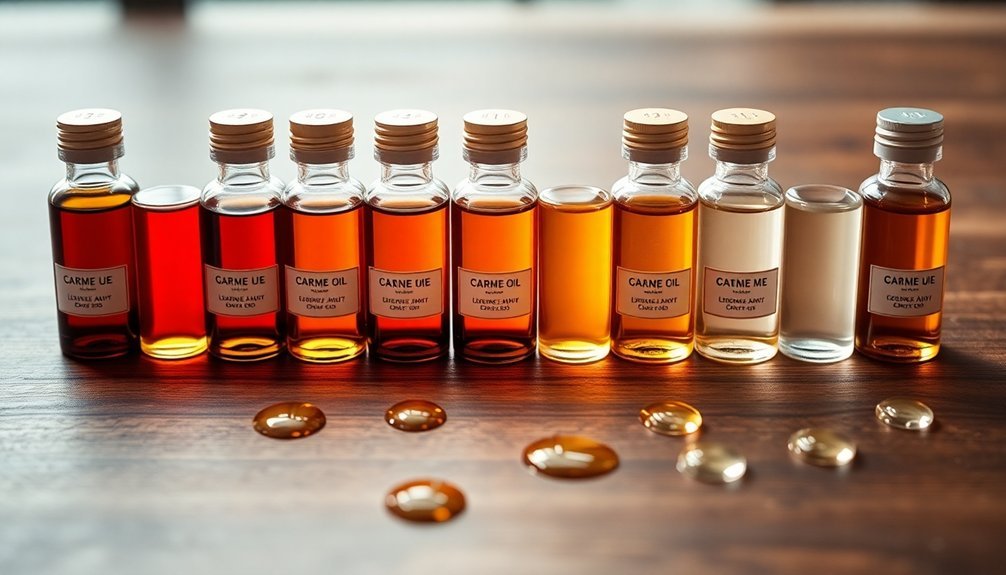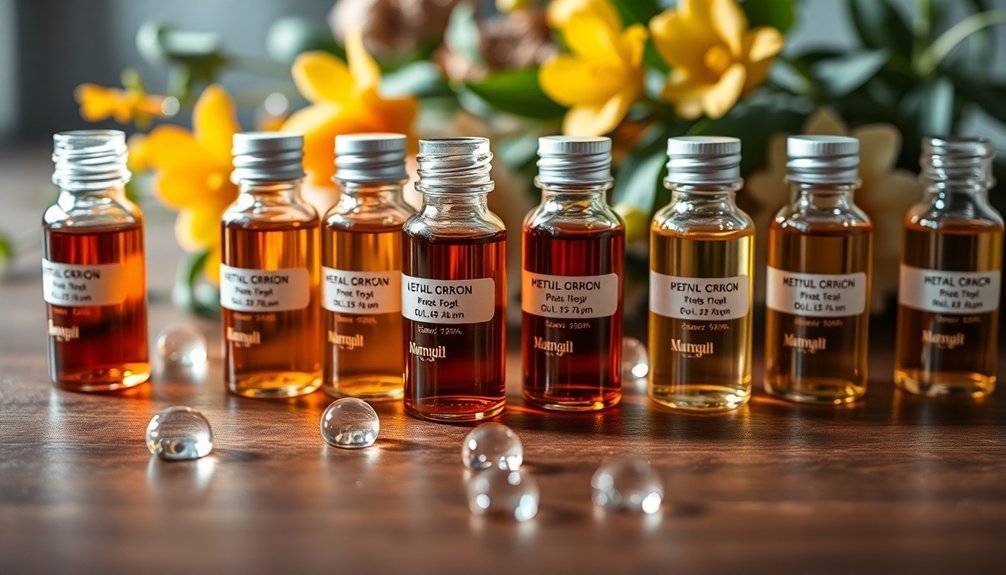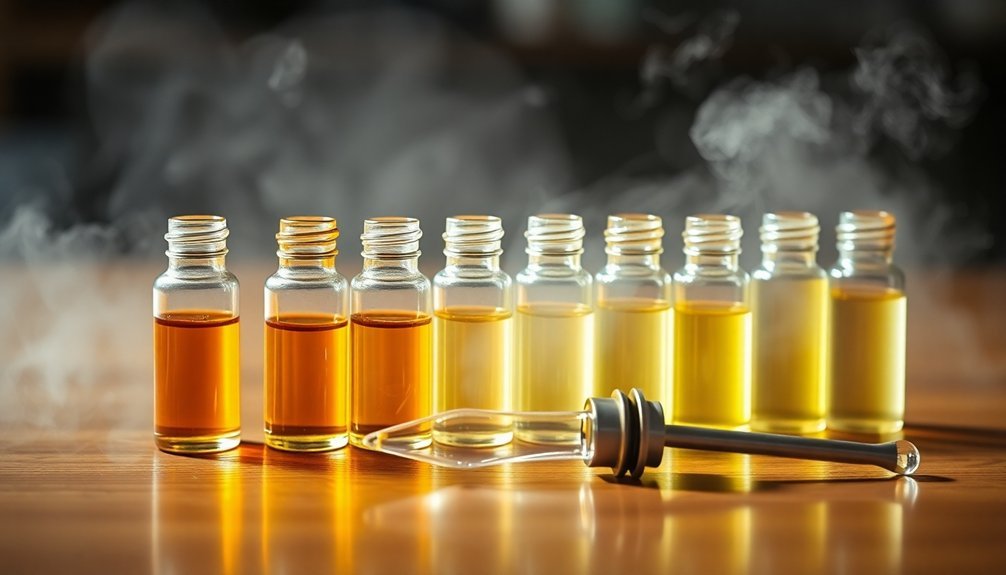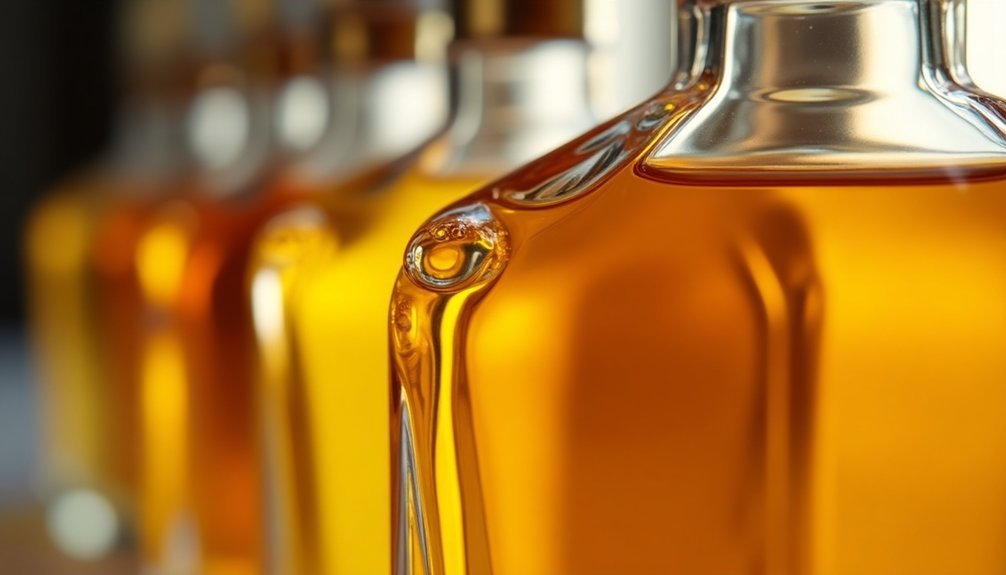Perfume dilution ratios follow a clear concentration hierarchy, from strongest to lightest. You'll find Extrait de Parfum at 20-30% oils, Eau de Parfum (EDP) at 15-20%, Eau de Toilette (EDT) at 5-15%, Eau de Cologne (EDC) at 2-4%, and Eau Fraiche at 1-3%. Each concentration requires specific mixing with either perfumer's alcohol or carrier oils. For best results, you'll need precise measurements and proper maturation time. Understanding these ratios is just the first step in mastering fragrance creation.
Understanding Perfume Oil Percentages

When it comes to perfume strength, the concentration of aromatic oils determines how long a fragrance will last and how strongly it projects.
The highest concentration you'll find is in Extrait de Parfum, containing 20-30% aromatic oils, which can last over 12 hours.
Eau de Parfum follows with 15-20% concentration, offering 4-6 hours of wear.
Eau de Toilette strikes a middle ground with 5-15% aromatic oils, lasting 3-5 hours and providing good projection for everyday use. The bright and fresh aroma makes it especially suitable for warmer months.
At the lighter end, you'll find Eau de Cologne with 2-4% concentration and Eau Fraiche with just 1-3%.
These lighter options won't last as long, with Cologne giving you about 2 hours of wear and Eau Fraiche lasting only an hour, but they're perfect for subtle, invigorating wear.
Essential Dilution Materials and Tools
Three key components form the foundation of proper perfume dilution: high-quality materials, precise measurement tools, and specialized equipment for handling and storage.
You'll need perfumer's alcohol or DPG as your primary diluent, with carrier oils reserved for specific oil-based formulations.
For accurate measurements, you'll want a reliable weighing machine, beakers, and disposable pipettes. A thorough maceration period of at least six weeks is crucial for proper fragrance development.
Don't forget amber glass bottles for storage during the maturation process, along with funnels and filters for the final preparation.
If you're planning larger-scale production, you'll benefit from having crimping machines and collar presses for bottle finishing.
Remember to calculate your dilutions by weight rather than volume, and always consider the specific concentration requirements of different materials – they'll vary from 1% to 10% depending on the ingredient.
Base Carrier Solutions for Different Concentrations

You'll find two primary approaches when working with perfume carriers: alcohol-based solutions using perfumer's alcohol, and natural oil-based carriers like fractionated coconut oil or jojoba.
While alcohol-based mixtures give you the classic spray-bottle application and quick evaporation, oil-based carriers offer better skin compatibility and longer-lasting scent retention. For optimal fragrance performance, experts recommend a 5% to 25% dilution with perfumer's alcohol.
The choice between water-alcohol mixtures and natural oil dilutions will largely depend on your desired end product, with alcohol bases working best for traditional sprays and oil carriers being ideal for roll-ons and solid perfumes.
Alcohol-Based Vs Water Mixtures
Nearly all classic perfumes rely on alcohol-based carrier solutions, with concentrated ethanol (95-96%) serving as the primary solvent.
You'll find that perfumers dissolve one part of fragrance composition in 2-9 parts of alcohol, then add water until reaching the desired clarity.
When working with alcohol-water mixtures, you'll need to conduct an opalescence test to determine the ideal ratio.
Add water until you notice slight cloudiness, then restore transparency with minimal alcohol.
This balance is essential because excess water can cause turbidity, especially with natural fragrances.
While oil and wax carriers offer longer-lasting effects, they don't provide the immediate scent release that alcohol does.
Professional perfumers prefer 200 proof SDA 40-B Ethanol for its superior ability to carry and release fragrances through evaporation.
Natural Oil Dilution Methods
Natural oil dilution methods follow precise ratios that vary based on the intended application.
When you're working with essential oils, you'll need to carefully measure your dilutions using carrier oils like coconut, jojoba, or sweet almond oil. For general aromatherapy use, stick to a 1-5% dilution, which means adding 9-43 drops of essential oil per ounce of carrier oil.
You'll want to adjust these ratios depending on your specific needs. For massage oils, use a 2-5% dilution, while chest rubs can go up to 7%.
If you're creating a bath blend, add 7-15 drops to a tablespoon of carrier oil. Remember that some potent oils require lower dilutions, and never apply undiluted oils to children, elderly, or pregnant women without professional guidance.
Measuring Techniques for Precise Ratios
You'll need a high-precision digital scale that measures to 0.01g for accurate perfume dilutions, ensuring each ingredient is weighed rather than measured by volume.
Keep your scale on a level surface and always tare between ingredients to maintain precise measurements of your fragrances and carriers.
For the smallest quantities, especially with potent materials, try adding a tiny amount before placing the container on the scale to prevent automatic zeroing issues.
Digital Scale Best Practices
While creating perfumes requires artistry and creativity, achieving consistent results necessitates precise measurements through proper digital scale usage.
You'll need a scale that measures to 0.01g for accurate formulations, as drop measurements are unreliable due to size variations.
When using your scale, always record the weight of each ingredient as you add it, and consider working in units of 10 or 100 to simplify your calculations.
Convert any existing drop-based formulas to weight measurements for consistency. You'll find that a quality digital scale isn't just a tool—it's an investment that enables precise dilution ratios and IFRA compliance.
Remember to test each batch and maintain detailed records in a spreadsheet.
This systematic approach guarantees your perfumes maintain consistent strength and character across different concentrations.
Solvent Measurement Tools
Accurate solvent measurements require three essential tools: glass measuring cylinders, calibrated pipettes, and precision beakers. You'll need these instruments to create consistent perfume dilutions and maintain quality control throughout your formulation process.
When working with solvents, you'll find disposable plastic pipettes particularly useful for small volumes, helping you avoid cross-contamination between different materials. Make sure you're regularly calibrating your equipment to prevent measurement errors.
For precise dilutions, you can rely on weight/weight calculations or use standard ratios like 1:9 for 10% solutions.
To maintain accuracy, always clean your tools with soapy water and ethanol before use. Remember to tare your scale and label your samples clearly.
For larger operations, you might consider automated systems that can handle multiple measurements in a single cycle.
Parfum Grade Dilution Methods

Creating parfum-grade dilutions requires precise measurements and specific equipment to achieve professional results. You'll need to calculate a 20% concentration for parfum-grade fragrances by weighing your concentrate and adding perfumer's alcohol until you reach the desired ratio.
| Equipment | Purpose |
|---|---|
| Amber Bottle | Maceration vessel |
| Glass Stirrer | Thorough mixing |
| Digital Scale | Precise weighing |
Pour your concentrate into a beaker, record its weight, then add alcohol gradually while stirring. Transfer this mixture to an amber bottle for maceration, allowing it to rest in a cool place. You'll want to agitate the bottle occasionally during this period. Once maceration is complete, filter the mixture using a funnel system, then transfer it to your final bottle using a clean pipette.
Eau De Parfum Mixing Calculations
Moving from parfum-grade concentrations, Eau de Parfum (EDP) requires its own specific calculations to achieve the ideal 15-20% fragrance oil concentration.
To create a 100ml EDP at 15% concentration, you'll need 15ml of fragrance oils and 85ml of alcohol. You can scale these proportions up or down based on your desired batch size. For precise measurements, you'll want to use graduated cylinders and accurate scales.
When mixing, add your fragrance oils to the alcohol gradually while stirring to guarantee even distribution. Once mixed, let your EDP mature for several weeks to develop its full character.
This concentration level offers a perfect balance – it's strong enough to last several hours but won't overwhelm. You'll find it's more concentrated than EDT (10-15%) but less intense than pure parfum (20-30%).
Eau De Toilette Formulation Guide

The art of formulating Eau de Toilette (EDT) requires a delicate balance of 5-15% perfume oils mixed with alcohol and water. You'll need precise measurements to create a fragrance that's both invigorating and long-lasting enough for daily wear.
| Component | Purpose |
|---|---|
| Perfume Oil | Provides fragrance notes and character |
| Alcohol | Dissolves oils and aids evaporation |
| Water | Adjusts strength and longevity |
When creating EDT, you're aiming for a lighter concentration than Eau de Parfum but stronger than cologne. It's perfect for daytime wear and warmer weather due to its moderate intensity. While DIY formulation is possible, you'll need a solid understanding of fragrance chemistry and compatibility. Professional training helps guarantee your EDT remains stable and maintains its balanced scent profile for several hours on the skin.
Eau De Cologne Blending Proportions
When you're mixing Eau de Cologne, you'll need to maintain the traditional 4-6% aromatic compound ratio by carefully adding your essential oils to a 60° alcohol base.
You can achieve this by measuring 4-6ml of fragrance oils for every 100ml of final product, ensuring you're following proper safety protocols for handling concentrated materials.
For a classic EDC formula, start with citrus oils like bergamot and lemon as your primary notes, then incorporate smaller amounts of aromatic and base notes while continuously mixing to achieve proper blending.
Oil-to-Alcohol Mixing Standards
Mastering proper oil-to-alcohol ratios forms the foundation of successful cologne blending.
When you're working with fragrance concentrations, you'll need to follow standard mixing ratios that determine the strength of your final product. For an Eau de Cologne (EDC), you'll want to maintain a 5:95 ratio of fragrance oils to alcohol, which means using 5 ml of oils for every 95 ml of alcohol in your mixture.
You can calculate your desired concentration using this simple formula: divide the volume of fragrance oils by the total volume, then multiply by 100.
For example, if you're creating a 100 ml batch of EDC, you'll need 5 ml of fragrance oils.
Always use precision tools like graduated cylinders to guarantee accurate measurements, and don't forget to let your blend mature for several weeks.
Classic EDC Formula Ratios
Traditional EDC formulas rely on three essential ratios that determine their characteristic light, invigorating scent profile.
You'll want to start with the fragrance oil concentration of 3-5% of your total volume, though you can adjust between 2-7% based on your desired strength. The majority of your blend will consist of alcohol, typically 90-95% of the total volume.
For the fragrance composition itself, you'll need to balance your aromatic notes carefully: use 30% top notes for immediate impact, 50% middle notes for the heart of the scent, and 20% base notes for lasting power.
When mixing, add your oils gradually to the alcohol base and let your creation mature for several weeks to achieve ideal blending of the components.
Proper Dilution Safety Steps
Safe blending of Eau de Cologne requires precise attention to dilution ratios and proper safety protocols. When creating a 100 ml EDC blend, you'll need to maintain a fragrance oil concentration of 3-5%, mixed with 95-97 ml of alcohol.
Always use precise measuring tools and follow a systematic approach to guarantee consistent results.
- Use graduated cylinders and accurate scales to measure your fragrance oils and alcohol precisely.
- Start with a patch test to check for skin sensitivity before applying your final blend.
- Mix oils gradually into the alcohol base, stirring thoroughly for even distribution.
- Document all measurements and ratios in a spreadsheet for reproducibility.
Remember to wear protective equipment and maintain a clean workspace throughout the blending process.
Let your mixture mature for several weeks to achieve the ideal fragrance profile.
Eau Fraîche Dilution Standards
Among all perfume dilutions, Eau Fraîche represents the lightest concentration, containing just 1-3% essential oils mixed primarily with water rather than alcohol.
You'll find this light composition creates a subtle, fresh scent that's perfect for casual everyday wear, especially during warmer months.
You won't get long-lasting fragrance from Eau Fraîche, but that's by design. You can reapply it throughout the day as needed, making it ideal if you prefer a more subdued scent profile.
Due to its minimal oil concentration, you'll typically find Eau Fraîche at a lower price point than other perfume types.
If you're new to fragrances or want something light for the office, Eau Fraîche offers an affordable way to experiment with scents without committing to stronger, more expensive concentrations.
Alcohol-to-Oil Conversion Charts

Understanding alcohol-to-oil ratios forms the foundation of successful perfume creation.
When you're working with essential oils and alcohol, you'll typically want to maintain a 20% essential oil to 80% alcohol ratio for a strong, balanced fragrance. You can adjust this ratio based on your desired strength, but don't exceed 30% essential oils to avoid potential skin reactions.
- For a 10% dilution in a 50ml batch, use 5ml essential oils and 45ml alcohol
- Converting from oil to alcohol requires precise calculations using weight/weight measurements
- A 20% dilution means using 20 drops of essential oil per 100 drops of base
- Lower ratios (5-15%) work well for lighter fragrances like eau de toilette
For accurate measurements, consider using a spreadsheet to track your calculations and scale your formulations effectively.
Water-Based Dilution Systems
While traditional perfumes rely on alcohol, water-based dilution systems represent an innovative shift in fragrance formulation. You'll find technologies like AquaElixir, AquaBoost Natco, and AquaScent leading this eco-friendly revolution, allowing for higher perfume concentrations of up to 10% in water.
| Technology | Key Benefits |
|---|---|
| AquaElixir | 100% biodegradable, natural moisturizing |
| AquaBoost Natco | 99% natural, COSMOS compliant |
| AquaScent | Even distribution, surfactant-based |
| Clean Reserve | Sustainable, skin-friendly formulas |
These systems require special attention to prevent oil-water separation through micro and nanoemulsion technologies. While you'll need to use preservatives like phenoxyethanol or glycerin to maintain stability, you're getting a more environmentally responsible product that's gentler on sensitive skin and offers additional moisturizing benefits.
Concentration Scaling for Custom Formulas

Crafting custom perfume formulas requires precise concentration scaling to maintain consistency across different batch sizes.
You'll need to account for specific gravity when adjusting proportions, as each essential oil has a unique weight compared to water. By converting your original formula into percentages, you can accurately scale up or down while maintaining the fragrance's integrity.
- Calculate the total weight by multiplying each oil's drops by its specific gravity
- Convert individual oil weights to percentages of the total blend
- Determine your target concentration level (Parfum 20%, EDP 15%, EDT 10%)
- Scale your formula using these percentages to achieve desired batch size
The concentration level you choose will impact the amount of fragrance oils needed – from 20% for Parfum to just 2% for aftershave.
Remember to adjust your solvent ratios accordingly to maintain the proper balance.
Frequently Asked Questions
How Do Temperature and Humidity Affect Perfume Dilution Ratios?
You'll notice your perfume evaporates faster in high temperatures and humidity, affecting its strength. In cold weather, it'll last longer but project less. Dry conditions speed up evaporation, while moisture helps retention.
Can Essential Oils Be Mixed Directly With Fragrance Oils During Dilution?
You shouldn't mix essential oils directly with fragrance oils during dilution. They're chemically different and can interact unpredictably. Always dilute them separately with appropriate carrier oils before combining for safety.
Why Do Some Perfumes Separate Into Layers After Dilution?
Your perfume separates when you haven't used proper emulsifiers or mixed incompatible ingredients. It's also common if you've used incorrect dilution ratios or haven't accounted for different ingredient densities in your blend.
Does the Age of Alcohol Base Affect Final Perfume Concentration?
Yes, your perfume's alcohol age can affect final concentration. As the alcohol base evaporates over time, you'll notice the fragrance becoming more concentrated, which could make your scent stronger than its original formulation.
How Do Different Skin Types Influence Perfume Concentration Requirements?
You'll need stronger concentrations for dry skin as fragrances evaporate quickly. If you have oily skin, use lighter concentrations since your skin naturally amplifies scents. Normal skin works well with most concentrations.
In Summary
You'll find that mastering perfume dilution ratios takes practice and precision. Whether you're working with extrait or cologne concentrations, keeping detailed measurements and using proper tools will guarantee consistent results. Start with basic ratios and gradually experiment with custom formulas. Remember, the key to successful dilution lies in understanding the delicate balance between oils, alcohol, and water in your chosen concentration.





Leave a Reply